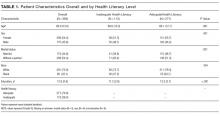Low Health Literacy Is Associated with Increased Transitional Care Needs in Hospitalized Patients
BACKGROUND: In discharge planning, a patient needs assessment helps to identify risk factors that should be addressed to promote a safe and effective transition in care. Low health literacy is associated with worse postdischarge outcomes, but little research has examined its relation to other addressable risk factors.
OBJECTIVE: To examine the association of health literacy with the number and type of transitional care needs (TCN) among patients being discharged to home.
DESIGN, SETTING, PARTICIPANTS: A cross-sectional analysis of patients admitted to an academic medical center.
MEASUREMENTS: Nurses administered the Brief Health Literacy Screen and documented TCNs along 10 domains: caregiver support, transportation, healthcare utilization, high-risk medical comorbidities, medication management, medical devices, functional status, mental health comorbidities, communication, and financial resources.
RESULTS: Among the 384 patients analyzed, 113 (29%) had inadequate health literacy. Patients with inadequate health literacy had needs in more TCN domains (mean = 5.29 vs 4.36; P < 0 .001). In unadjusted analysis, patients with inadequate health literacy were significantly more likely to have TCNs in 7 out of the 10 domains. In multivariate analyses, inadequate health literacy remained significantly associated with inadequate caregiver support (odds ratio [OR], 2.61; 95% confidence interval [CI], 1.37-4.99) and transportation barriers (OR, 1.69; 95% CI, 1.04-2.76).
CONCLUSIONS: Among hospitalized patients, inadequate health literacy is prevalent and independently associated with other needs that place patients at a higher risk of adverse outcomes, such as hospital readmission. Screening for inadequate health literacy and associated needs may enable hospitals to address these barriers and improve postdischarge outcomes.
© 2017 Society of Hospital Medicine
Data Collection
TCN assessment was developed from published patient risk tools and the ITC framework.2,6,22 The assessment has 10 domains composed of 49 individual items as follows: (1) caregiver support (caregiver support not sufficient for patient needs), (2) transportation (relies on public or others for transportation and misses medical care because of transportation), (3) health care utilization (no primary care physician, unplanned hospitalization in the last year, emergency department [ED] visit in the last 6 months, or home health services in the last 60 days), (4) high-risk medical comorbidities (malnutrition or body mass index <18.5, renal failure, chronic pain, diabetes, heart failure, COPD, or stroke), (5) medication management provider or caregiver concern (cannot provide medication list, >10 preadmission medications, high-risk medications [eg, insulin, warfarin], poor medication understanding, or adherence issue identified), (6) medical devices (vascular access, urinary catheter, wounds, or home supplemental oxygen), (7) functional status (weakness of extremities, limited extremity range of motion, difficulty with mobility, falls at home, or activities of daily living challenges), (8) mental health comorbidities (over the past month has felt down, depressed, or hopeless or over the past month has felt little interest or pleasure in doing things, high-risk alcohol use, or high-risk substance use), (9) communication (limited English proficiency or at risk for limited health literacy), and (10) financial resources (no health insurance, skips or rations medicines because of cost, misses medical care because of cost, or misses medical care because of job).
The 49 items of the TCN assessment were documented as being present or absent by nurse TCCs at the time patients were enrolled in the transitional care program, based on patient and family interview and chart review, and the items were later extracted for analysis. Patients were determined to have a domain-level need if they reported a need on any individual item within that domain, resulting in a binary score (any need present, absent) for each of the 10 TCN domains.
Health literacy was assessed by using the Brief Health Literacy Screen (BHLS), which is administered routinely by nurses at hospital intake and documented in the medical record, with completion rates of approximately 90%.23 The BHLS is a 3-question subjective health literacy assessment (scoring range 3-15) that has been validated against longer objective measures24 and shown to predict disease control and mortality.18,25 To improve the stability of scores (for patients who completed the BHLS more than once because of repeat hospitalizations) and to reduce missing values, we calculated the patient’s mean BHLS score for assessments obtained between January 1, 2013, and December 31, 2014. Patients were then categorized as having inadequate health literacy (BHLS ≤ 9) or adequate health literacy (BHLS > 9).18,25 Demographic information was extracted from patient records and included age, sex (male/female), marital status (married/without a partner), race (white/nonwhite), and years of education. Income level and primary language were not available for analysis.
Statistical Analysis
Patient characteristics and TCNs were summarized by using the frequency and percentages for categorical variables and the mean and standard deviation (SD) for continuous variables. We compared patient characteristics (age, sex, marital status, race, and education) between health literacy groups (inadequate vs adequate) by using χ2 or analysis of variance as appropriate. We assessed Pearson correlations among the 10 TCN domains, and we examined differences in reported needs for each of 10 TCN domains by the level of health literacy by using the χ2 test. Because the TCN domain of communication included low health literacy as one of its items, we excluded this domain from subsequent analyses. We then compared differences in the number of TCNs documented (scoring range 0-9) by using an independent samples Student t test.
Multivariate logistic regression models were then constructed to examine the independent association of inadequate health literacy with 8 TCN domains while controlling for age, sex, marital status, race, and education. Patients with incomplete demographic data were excluded from these models. Additionally, these analyses excluded 2 TCN domains: the communication domain for reasons noted above and the high-risk medical comorbidity domain because it ended up being positive in 98.4% of patients. Statistical significance was set at an alpha of 0.05. All analyses were performed by using SPSS Statistics for Mac, version 23.0 (IBM Corp., Armonk, New York)







